Kittredge Cherry's Blog: Q Spirit, page 61
January 6, 2013
Epiphany: Queer eye for the Magi
 Three stylish Magi wear fabulous outfits on a 1972 German Christmas stamp (Wikimedia Commons)
Three stylish Magi wear fabulous outfits on a 1972 German Christmas stamp (Wikimedia Commons)Reimagining the three kings as queer or female gives fresh meaning to Epiphany, a holiday celebrating the visit of the Magi to the infant Jesus. It is observed on Jan. 6.
The word “epiphany” also refers to a sudden, intuitive perception. By looking at the Bible and church history from a LGBT viewpoint, people can experience new insights -- their own personal “epiphanies” of understanding. New interpretations of the Magi include:
Queer Magi. Biblical scholarship suggests that the Magi were eunuchs -- people who today would be called gay, queer or transgender.
Female Magi appear in a controversial painting by Janet McKenzie.
Queer gifts are presented to the Christ child in an icon by William Hart McNichols.
Queer MagiThe Magi played the shamanic role often filled by eunuchs, an ancient term for LGBT people, says Nancy Wilson in her book Our Tribe: Queer Folks, God, Jesus, and the Bible

 .” She writes:
.” She writes:“They were Zoroastrian priests, astrologers, magicians, ancient shamans from the courts of ancient Persia. They were the equivalent of Merlin of Britain. They were sorcerers, high-ranking officials, but not kings—definitely not kings. But quite possibly, they were queens. We’ve always pictured them with elaborate, exotic, unusual clothing—quite festive, highly decorated and accessorized! …Also, the wise eunuchs, shamans, holy men were the only ones who had the forethought to go shopping before they visited the baby Jesus!
They also have shamanistic dreams. They deceive evil King Herod and actually play the precise role that many other prominent eunuchs play in the Bible: they rescue the prophet, this time the Messiah of God, and foil the evil royal plot against God’s anointed.”
The concept of the queer Magi is amplified by Virginia Ramey Mollenkott, author of Omnigender
 . “My guess is that they were people who today would be termed transwomen,” she writes in the brochure “Gender Identity and Our Faith Communities.”
. “My guess is that they were people who today would be termed transwomen,” she writes in the brochure “Gender Identity and Our Faith Communities.”Eunuchs and cross-dressers were surprisingly common in the Mediterranean world of the Bible and later. By happy coincidence, a cross-dressing saint happens to have a feast day on Jan. 5, the day before Epiphany. Apollinaria of Egypt, put on men’s clothing and presented herself as a eunuch named Dorotheos in order to live as a monk. For more info on Apollinaria and other cross-dressing saints in early Christian communities, visit Queering the Church.
 “Epiphany” by Janet McKenzie, copyright 2003.
“Epiphany” by Janet McKenzie, copyright 2003.www.janetmckenzie.com
Collection of Barbara Marian, Harvard, IL
Female Magi A multi-racial trio of female Magi visit the baby Jesus and his mother in “Epiphany” by Janet McKenzie. Instead of the traditional three kings or three wise men, the artist re-interprets the Magi as wise women from around the world.
The unconventional portrayal of the Magi makes good theological sense. Barbara Marian, who commissioned the painting, explains: “The story of the Magi in the Gospel of Matthew allowed the Jewish followers of Jesus to imagine the unthinkable -- God’s grace extending to the outsiders, the gentiles. Who are the outsiders in our world? Can we imagine the favor of God extending beyond the human boundaries of race, class, nationality, ethnicity, religious devotion, and gender?”
Marian commissioned “Epiphany” for the Nativity Project, which revisits and revitalizes the Gospel with new images of women. “It’s easy to get so caught up in regal images of Matthew’s night visitors that we miss the core message -- Christ for all people,” Marian says.
Conservative Christians protested against the inclusive “Epiphany” in 2007 when it appeared on the Christmas cards of the Most Reverend Katharine Jefferts Schori, presiding bishop of the Episcopal Church.
The Standing Committee of the Episcopal Diocese of Ft. Worth, Texas, sent a notice to clergy and 2007 convention delegates condemning Jefferts Schori for her choice of art. “Happy Multicultural Feminist Celebration Day,” sneered the headline of a traditional Anglican blog where nearly 100 comments were posted condemning the image as “stupid,” “faux-nouveau hipster theology” and worse. For more info, see our previous post Conservatives blast inclusive Christmas card.
McKenzie denies the accusations that she is trying to be divisive and rewrite scripture. “Of course this is as far from my thinking as possible,” she says. “I feel called to create sacred and secular art that includes and celebrates those systematically ignored, relegated and minimized, and for the most part that is women and people of color.”
The artist continues to be amazed that her loving images provoke so much anger. “Even this gentle image of a loving Holy Mother and Child, with no agenda except to include and honor us as the nurturing feminine beings we are, surrounded in community with other women, is still misunderstood -- even at this late date,” she says.
McKenzie has weathered even bigger storms before. Her androgynous African American “Jesus of the People” painting caused international controversy when Sister Wendy of PBS chose it to represent Christ in the new millennium.
Critics focus on the content of McKenzie’s art, but her outstanding artistic style is one reason that her work attracts attention. The Vermont artist uses drawing and line with oils to build images that glow. Her painting technique and pastel colors are reminiscent of American Impressionist Mary Cassatt, who is famous for painting intimate scenes of mothers and their children.
The controversy over McKenzie’s work is a reminder of the power of art, and the continuing need for progressive spiritual images. Opposition seems to fuel her passion to paint. “We all need to find ourselves included within the sacred journey of life, and afterlife,” McKenzie says. “I have been surprised to find archaic and out-dated hate still in place, still alive and well and fueled by fear, in response to some of my art. I have made the decision to respond to such hate not in the way it comes to me, but by creating ever more inclusive art that confronts prejudice and hate. The only path open to any of us is the one of love.”
McKenzie’s art is featured in my book “Art That Dares: Gay Jesus, Woman Christ, and More” and her book “Holiness and the Feminine Spirit
 .”
.”(Special thanks to Barbara Marian for permission to quote from her article “Recasting the Magi.”)

“The Epiphany: Wisemen Bring Gifts to the Child”By William Hart McNichols © 1984, fatherbill.org
Queer gifts
Father William Hart McNichols paints another kind of queer Epiphany. McNichols is a New Mexico artist and Roman Catholic priest whose gay-positive icons have caused controversy. He worked at an AIDS hospice in New York City from 1983-90, when many in the gay community were dying of the disease. During that period he painted “The Epiphany: Wisemen Bring Gifts to the Child.”
St. Francis and St. Aloysius are the wise men visiting the baby Jesus in this icon. Instead of the usual gold, frankincense and myrrh, the “gifts” they bring to the Christ child are people with AIDS, perhaps gay men. The baby Jesus reaches eagerly to receive these gifts. The child and his mother appear in a form popular in Mexico and other Latino cultures as Our Lady of Guadalupe and El Santo Niño de Atocha. The halo around them echoes the colors of the rainbow flag of the LGBT community. McNichols offers a prayer with this icon:
Dearest Mary, Our Lady of Guadalupe,
Mother of the poor and the oppressed,
we watch full of reverence
and joy as St. Francis and
St. Aloysius bring the gifts of
these two people afflicted with AIDS
to the Holy Child in your arms,
who is so eager to receive them.
Teach us to find and embrace
your Son Jesus in all peoples,
but most especially those who
are in greatest need and
who suffer most.
Amen
In closing, the question arises: What gifts are queer people bringing today to Christ, the church and the world?
___
Related links:
Three Queers from the East: Thoughts for the Epiphany (Queering the Church Blog)
LGBTQ Nativity 4: Queer Magi visit Mary, Josephine and Jesus
____
This post is part of the LGBT Holidays series by Kittredge Cherry at the Jesus in Love Blog. The series celebrates religious and spiritual holidays, holy days, feast days, festivals, anniversaries, liturgical seasons and other occasions of special interest to LGBT and queer people of faith and our allies.
Copyright © Kittredge Cherry. All rights reserved.
http://www.jesusinlove.blogspot.com/
Jesus in Love Blog on LGBT spirituality and the arts
Published on January 06, 2013 00:06
December 31, 2012
Welcome the New Year with rainbow candles!

"Rainbow Reflections" by Kittredge Cherry
Welcome the new year by lighting rainbow candles for Bridge of Light, a new winter holiday honoring LGBT culture.

Rainbow Arch candle holder
People celebrate Bridge of Light by lighting six candles, one for each color of the rainbow flag, on New Year’s Eve -- or from Dec. 26 to Jan. 1, one candle per day.
Each candle stands for a spiritual principle and its expression in the lives and history of lesbian, gay, bisexual, transgender and queer people. The candles are intended to provide a starting point for individual and group meditations on these principles:

1. Red - The Root of Spirit (Community)
2. Orange - The Fire of Spirit (Eros, sexuality, passion)
3. Yellow - The Core of Spirit (Self-esteem, courage)
4. Green - The Heart of Spirit (Love)
5. Blue - The Voice of Spirit (Justice, self-expression)
6. Purple - The Eye of Spirit (Wisdom)
7. All Candles - The Crown of Spirit (Spirituality)
Together these colors form a rainbow, a time-honored symbol of a bridge between two worlds: heaven and earth, East and West, male and female, queer and non-queer.
The principles are beautifully expressed in a new benediction prayer written for Bridge of Light by Yewtree (Yvonne Aburrow) of the Dance of the Elements Blog:
Let us embody the values of the rainbow flag of lesbian, gay, bisexual and transgender people.
Red is the root of spirit, found in beloved community,
Orange is for Eros, the fire of spirit, the experience of erotic connection,
Yellow is for self-esteem, the strong core of spirit,
Green is for love, the heart of spirit, the verdant growth of the soul,
Blue is for self-expression, the voice of spirit, calling out for justice,
Purple is the eye of spirit, which sees inwardly with the eye of wisdom.
And all the colours together form the crown of spirit, the experience of spirituality.
Joe Perez, author of “Soulfully Gay
 ,” founded Bridge of Light in 2004. It has obvious parallels to Kwanzaa, the African-American cultural holiday started by Ron Karenga in 1966.
,” founded Bridge of Light in 2004. It has obvious parallels to Kwanzaa, the African-American cultural holiday started by Ron Karenga in 1966.“Bridge of Light is an interfaith and omni-denominational cultural and spiritual tradition,” Perez says. “The annual winter ritual...has helped to draw attention to the positive contributions made by members of the LGBT community in the areas of spiritual growth, inner transformation, and religious leadership.” His most recent post on the subject is The Seven Principles of Bridge of Light. (GaySpirituality.com)

Bridge of Light continues to evolve. Aburrow suggested adding sacred foods, such as “rainbow-tinted marble cake maybe, or one food of each colour?”
I like the idea of doing a daily candle for each color, but every year Dec. 26-31 is such a busy week for me! I wonder if Bridge of Light could also be celebrated at the summer solstice in connection with LGBTQ Pride?
The following summary of the seven principles of Bridge of Light includes historical time periods, foods and more about the chakras, the energy centers of the human body. I synthesized and developed this info based on the resource links at the end of this post. For Jesus in Love readers I highlighted Christian history with links to LGBT Saints. The seven principles are also matched with the seven models of the queer Christ from gay theologian Patrick S. Cheng’s new book “From Sin to Amazing Grace: Discovering the Queer Christ.
 .
.1. Red - The Root of Spirit (Community)

Red evokes life, energy and blood. Shadow side: violence/death.
Time period: Before Christ / Before the Common Era
Celebrate same-sex love in goddess worship, paganism and other pre-patriarchal spiritualities, in ancient myths and cultures, and in the Hebrew Scriptures/Old Testament.
Living and Self-Loving Christ (sin as shame, grace as pride)
Mary, Diana and Artemis: Feast of Assumption has lesbian goddess roots
David and Jonathan
Ruth and Naomi
Foods: Root vegetables (carrots, beets, potatoes, etc.), protein-rich foods, sweet and spicy tastes.
2. Orange - The Fire of Spirit (Eros)

Orange evokes fire, passion, sexuality and relationships. Shadow side: lust/addiction.
Time period: 1st - 4th centuries
Celebrate same-sex love in the life of Christ, among early Christians, in the late Roman Empire and other cultures.
Erotic Christ (sin as exploitation; grace as mutuality)
Historical Jesus and the Beloved Disciple
Mary and Martha
Sergius and Bacchus
Perpetua and Felicity
Foods: Foods growing from ground-level to 2 feet (melons, strawberries, squash, etc.), sweet and salty tastes.
3. Yellow - The Core of Spirit (Self-Esteem)

Yellow evokes courage, confidence and personal power. Shadow side: fear/anger.
Time period: Middle Ages, 4th - 15th centuries
Celebrate same-sex love in medieval times. Queer medieval Christians include pairs of lovers in monasteries and convents, writers of homoerotic verse, and cross-dressing women. Medieval mystics describe erotic-ecstatic union with God.
Out Christ (sin as the closet; grace as coming out)
Brigid and Darlughdach (c.451-525)
Symeon of Emessa and John (c. 522-c. 588)
Hildegard of Bingen (1098-1179)
Aelred of Rievaulx (c.1110-1167)
Francis of Assisi (1181-1226)
Rumi (1207 - 1273)
Julian of Norwich (1342-c. 1417)
Foods: Foods growing 2-6 feet above the ground (grains, sunflower seeds etc.), bitter and minty tastes.
4. Green - The Heart of Spirit (Love)

Green evokes growth, nature, balance and compassion. Shadow side: jealousy/greed, hatred.
Time period: Renaissance, 15th-17th centuries (c. 1400-1699)
Celebrate same-sex love in the era that included the Age of Discovery, the Protestant Reformation and the invention of the printing press.
Transgressive Christ (sin as conformity; grace as deviance)
Joan of Arc (c.1412-1431)
John of the Cross (1542-1591)
Juana de la Cruz (1648-1695)
Gay Popes, Papal Sodomites (Queering the Church Blog)
Foods: Green leafy vegetables (broccoli, spinach, green tea, etc.), sour and savory tastes.
5. Blue - The Voice of Spirit (Justice and Self-Expression)

Blue evokes peace, communication and independence. Shadow side: depression/arrogance.
Time period: Modern, 1700 to 1950
Celebrate same-sex love in modern times, including gender role evolution in Romanticism, Transcendentalism, secular philosophy, and the movements for women’s suffrage and abolition.
Liberator Christ (sin as apathy; grace as activism)
Bernardo de Hoyos (1711-1735): Mystical same-sex marriage with Jesus
Jemima Wilkinson / Publick Universal Friend (1752-1819) Queer American preacher
John Henry Newman (1801-1890) and Ambrose St. John
Christina Rossetti (1830-1894) Poet who wrote Christmas carols
We’wha of Zuni (1849-1896)
Foods: Food that grows 6 feet or more above ground (apples, oranges, avocadoes, etc.), sour and salty tastes.
6. Purple - The Eye of Spirit (Wisdom)

Purple evokes vision, intuition and understanding. Shadow side: passivity/nightmares.
Time period: 1950 to present
Celebrate same-sex love and gender role defiance in recent LGBT, queer, feminist and black liberation movements, including the struggle for LGBT religious rights. LGBT-affirming churches and religious institutions are founded. Pluralistic expressions of sexuality and gender multiply, but some are martyred in anti-gay hate crimes.
Interconnected Christ (sin as isolation, grace as interdependence)
Saints of Stonewall
Harvey Milk
Bayard Rustin
Mychal Judge: Gay saint of 9/11
Matthew Shepherd
Pauli Murray
Foods: Dark purple foods (blueberries, purple grapes, red wine, etc.), subtle tastes (poppyseed, lavender, etc.).
7. All Colors / White - The Crown of Spirit (Spirituality)

When all the colors of the rainbow mix, they create white light, evoking universal consciousness.
Time period: Now and the future
Celebrate same-sex love now and in the future! Be a witness of love in all its expressions. Sainthood is a state to which all are called.
Hybrid and All-Encompassing Christ (sin as singularity; grace as hybridity)
Foods: Fasting. Instead of eating, inhale incense and smudging herbs such as sage. Or… Celebrate with a slice of rainbow cake!
___
Links to other resources for Bridge of Light:
Rainbow Christ Prayer: LGBT flag reveals the queer Christ (Kittredge Cherry and Patrick Cheng)
The Story of the "Queer Saints and Martyrs" by Terence Weldon
Author Carolyn Myss connects the seven chakras with the seven sacraments of the church in her book “Anatomy of the Spirit: The Seven Stages of Power and Healing
 .”
.” CD set of meditations based on the chakras, “Activating Your Chakras Through the Light Rays
 .” It’s definitely “new age,” but it’s the best of its kind.
.” It’s definitely “new age,” but it’s the best of its kind. S(t)even Years: A 7-year art project based on the chakras by Steven Reigns
Happy Bridge of Light, everybody! Like the rainbow, may we embody all the colors of the world! Be renewed and refreshed as the New Year begins! May 2013 bring everyone peace, health and prosperity!
___
Image credits:
Chakra images by Anodea Judith of SacredCenters.com
____
This post is part of the LGBT Holidays series by Kittredge Cherry at the Jesus in Love Blog. The series celebrates religious and spiritual holidays, holy days, feast days, festivals, anniversaries, liturgical seasons and other occasions of special interest to LGBT and queer people of faith and our allies.
Copyright © Kittredge Cherry. All rights reserved.
http://www.jesusinlove.blogspot.com/
Jesus in Love Blog on LGBT spirituality and the arts
Published on December 31, 2012 08:55
December 29, 2012
David and Jonathan: Love between men in the Bible
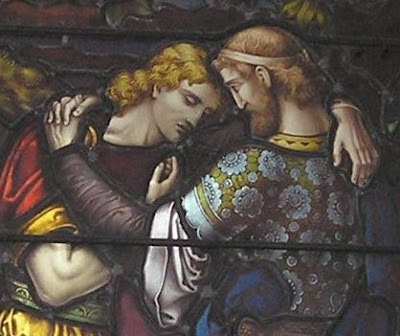
David and Jonathan window (detail) from St. Mark's Portobello, Edinburgh, Scotland, 1882
Love between men is celebrated in the Bible with the story of David and Jonathan. They lived about 3,000 years ago, but they still inspire LGBT people of faith -- and many others. David’s feast day is today (Dec. 29).
The two men met when David was a ruddy young shepherd. Jonathan, a courageous warrior, had returned victorious from battle. Jonathan was the eldest son of Saul, Israel’s first king. David was taken to see King Saul right after beheading the Philistine giant Goliath. Scholars estimate that David was about 18 and Jonathan was at least 10 years older.
Jonathan fell in love at first sight of the handsome young hero. As the Bible says, “The soul of Jonathan was knit to the soul of David.” Their story gets more chapters in the Bible than any other human love story.
David, the second king of Israel, was an acclaimed warrior, musician and poet. He is credited with composing many of the psalms in the Bible. The gospel genealogies list David as an ancestor of Jesus.
The modern idea of sexual orientation didn’t exist in Biblical times, but the powerful love story of Jonathan and David in 1 and 2 Samuel suggests that same-sex couples are affirmed and blessed by God.
Artists throughout the ages have tried to capture the drama and passion of their story, beginning with the moment that David and Jonathan met. A beautiful romantic version of their first meeting appears on their stained-glass window at St. Mark's Portobello, a Scottish Episcopal church in Edinburgh. The inscription states, “The soul of Jonathan was knit with the soul of David” (1 Samuel 18:1).
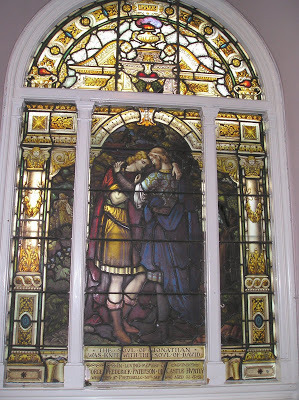
David and Jonathan window from St. Mark's Portobello, Edinburgh, Scotland, 1882
Created in 1882, the window has a dedication at the bottom: “In loving memory of George Frederick Paterson of Castle Huntly who died at Portobello, 30th Sept. 1890, aged 33.” All that is known about Paterson is that he was in the army and unmarried. The window was paid for by "a friend."
Soon after David and Jonathan met, the two men expressed their commitment by making a covenant with each other. The dramatic moment is described in 1 Samuel 18:3-4: “Then Jonathan made a covenant with David, because he loved him as his own soul. Jonathan stripped himself of the robe that he was wearing, and gave it to David, and his armor, and even his sword and his bow and his belt.”
Ryan Grant Long, a young gay artist based in Wisconsin, emphasizes the homoeroticism of the gesture as Jonathan strips off his robe and wraps it around David with a kiss on the neck in the image at the top of this post. For more about Long, see my previous post Artist paints history's gay couples.
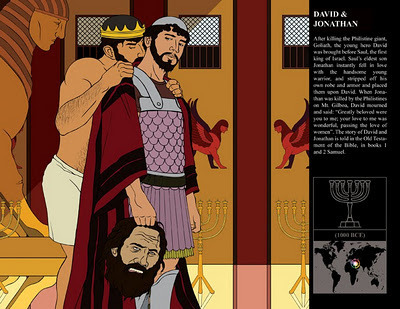
“David and Jonathan” by Ryan Grant Long
A more traditional view is presented by 16th-century Italian painter Cima da Conegliano. In both images David is still carrying the head of Goliath as he bonds with his new friend Jonathan, hinting at the union of violence and eroticism.
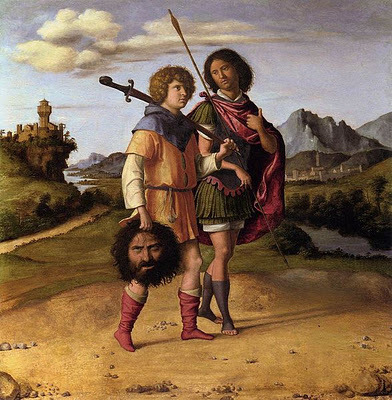
“David and Jonathan” by Italian painter Cima da Conegliano, 1505-1510 (Wikimedia Commons)
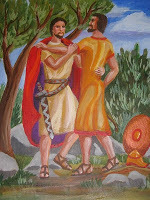
“Jonathan Made
a Covenant with David”
by Trudie Barreras
Collection of
First Metropolitan
Community Church
of Atlanta
In contrast Atlanta artist Trudie Barreras shows the new friends both putting aside their armor to make a covenant with each other (left).
The Bible chronicles the ups and downs of David and Jonathan’s relationship over the next 15 years, including tears and kisses. King Saul is jealous of David's popularity and keeps trying to kill him, while his son Jonathan rescues his friend in various ways. An 18th-century German “friendship medal” (below) captures another highlight as Jonathan pledges to David, “I will do the desires of your heart” (“Ich will die thun was dein Herz begehrt”) from 1 Samuel 20:4.
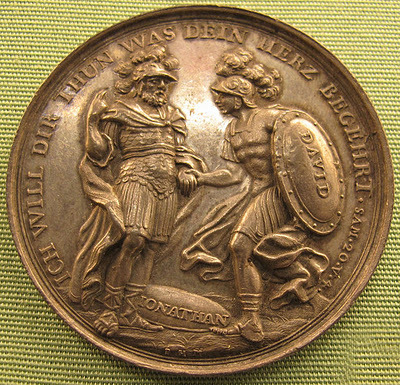
German friendship medal of Jonathan and David by Philipp Heinrich Müller, c.1710 (Wikimedia Commons)
Other artists focus on a dramatic moment that came later when Jonathan met David at a pile (or "ezel") of stone to warn him that Saul intended to kill him. An 1860 woodcut by German artist Julius Schnorr von Carolsfeld illustrates that tearful farewell scene from 1 Samuel 20: 41-42:
"Then they kissed each other and wept together—but David wept the most. Jonathan said to David, “Go in peace, for we have sworn friendship with each other in the name of the Lord, saying, ‘The Lord is witness between you and me, and between your descendants and my descendants forever.’”
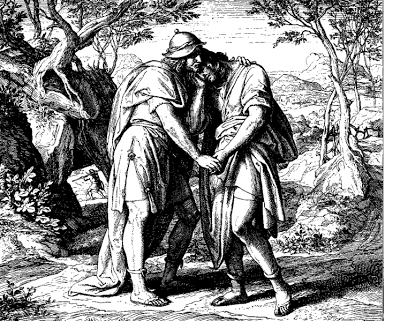
“David and Jonathan” woodcut for "Die Bibel in Bildern", 1860, by Julius Schnorr von Carolsfeld (Wikimedia Commons)
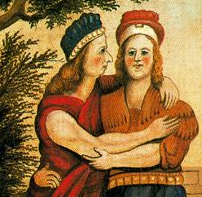
Detail from "David and Jonathan
at the Stone Ezel"
by Edward Hicks
Another version of the farewell scene was painted by American folk artist and Quaker minister Edward Hicks in 1847. In both paintings a boy can be seen carrying away their weapons. In the lower right Hicks places a scene of the Good Samaritan rescuing a downtrodden man. Interestingly, the Jonathan and David window at St. Mark's Portobello is also paired with a window showing the Good Samaritan.
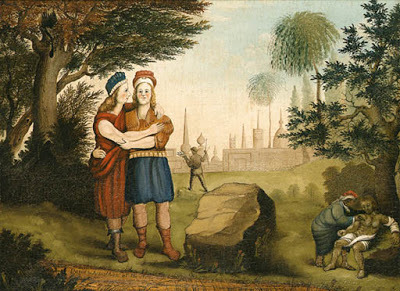
"David and Jonathan at the Stone Ezel" by Edward Hicks, 1947
David and Jonathan became so close that it looked like someday they would rule Israel together. But that day never came because Jonathan was killed in battle. David mourned deeply for him with his famous lament from 2 Samuel 1:26:
I grieve for you, Jonathan my brother;
you were very dear to me.
Your love for me was wonderful,
more wonderful than that of women.
The love between the two men is honored in a golden icon by Brother Robert Lentz. Unlike most images of Jonathan and David, the Lentz icon shows Christ above blessing their relationship. It is one of 10 Lentz icons that sparked a controversy in 2005 when conservative Roman Catholic leaders accused Lentz of glorifying sin.
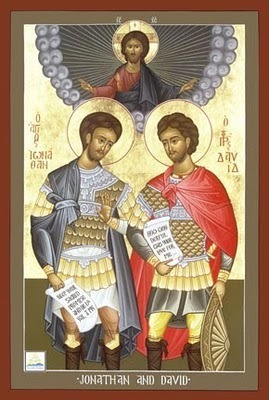
Jonathan and David by Br. Robert Lentz, OFM
www.trinitystores.com
Gay-positive Bible scholars have written extensively about the relationship between David and Jonathan. The classic book on the subject is “Jonathan Loved David: Homosexuality in Biblical Times” by Thomas Horner.


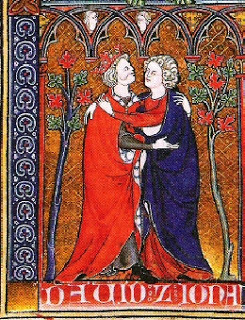
Jonathan and David embrace.
Manuscript illustration, circa 1300
La Somme le roy
The love between the two men is celebrated is also celebrated in literature, including the poem “The Meeting of David and Jonathan” by 19th-century English poet John Addington Symonds. He is known as an early advocate of male love (homosexuality) and wrote many poems inspired by his own homosexual affairs. In “The Meeting of David and Jonathan” he writes:
There by an ancient holm-oak huge and tough,
Clasping the firm rock with gnarled roots and rough,
He stayed their steps; and in his arms of strength
Took David, and for sore love found at length
Solace in speech, and pressure, and the breath
Wherewith the mouth of yearning winnoweth
Hearts overcharged for utterance. In that kiss
Soul unto soul was knit and bliss to bliss.
The full poem appears in “Many Moods: A Volume of Verse
 ” by Symonds.
” by Symonds.It’s impossible to know whether David and Jonathan expressed their love sexually. Some consider David to be bisexual, since the Hebrew scriptures also recount how he committed adultery with Bathsheba and later made her one of his eight wives. There is no doubt that many people today do honor David and Jonathan as gay saints.
Their story is used by contemporary LGBT Christians to counteract conservatives who claim that the Bible condemns homosexuality. The “David loved Jonathan” billboard below is part of the Would Jesus Discriminate project sponsored by Metropolitan Community Churches. It states boldly, “David loved Jonathan more than women. II Samuel 1:26.” For more info on the billboards, see our previous post, “Billboards show gay-friendly Jesus.”

David loved Jonathan billboard from GLBT Christian billboards from WouldJesusDiscriminte.com and WouldJesusDiscriminte.org
___
Related links:
David and Jonathan: Why did God focus on their intimate partnership? (GayChristian101)
Homosexuality and Tradition: David and Jonathan (Pharsea’s World)
Subjects of the visual arts: David and Jonathan (glbtq.com)
David the Prophet and Jonathan, His Lover (Queer Saints and Martyrs - And Others)
David y Jonatán: El amor entre hombres en la Biblia (Santos Queer)
Bible story of David and Jonathan’s first meeting: 1 Samuel 18
Bible story of Jonathan’s death: 2 Samuel 1
___
Special thanks to Ruth Innes for the photo and info on the stained-glass window at St. Mark's Portobello.
Special thanks to Mitch Gould, curator of LeavesOfGrass.org, for introducing me to David and Jonathan at the Stone Ezel by Edward Hicks. It is part of their project on LGBT Quaker history.
________
This post is part of the LGBT Saints series at the Jesus in Love Blog. Saints and holy people of special interest to gay, lesbian, bisexual and transgender (GLBT) people and our allies are covered on appropriate dates throughout the year.
Copyright © Kittredge Cherry. All rights reserved.
http://www.jesusinlove.blogspot.com/
Jesus in Love Blog on LGBT spirituality and the arts
___
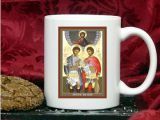
Icons of Jonathan and David and many others are available on cards, plaques, T-shirts, mugs, candles, mugs, and more at Trinity Stores

Published on December 29, 2012 12:38
December 27, 2012
John the Evangelist: Beloved Disciple of Jesus

“Jesus and the Beloved Disciple” by Laurie Gudim
John the Evangelist is commonly considered to be Jesus’ “Beloved Disciple” -- and possibly his lover. His feast day is today (Dec. 27).
The love between Jesus and John has been celebrated by artists since medieval times. And the idea that they were homosexual lovers has been causing controversy at least since the 16th century.
John was an apostle of Jesus and is the presumed author of the Gospel of John, the Book of Revelation and the Epistles of John. The Bible describes their warm relationship in depth. John left his life as a fisherman to follow Jesus, who nicknamed him “son of thunder.” John participated in many of the main events in Christ’s ministry. He was one of the three who witnessed the raising of Jairus' daughter, the transfiguration and Jesus' agony in Gethsemane.
The unnamed “disciple whom Jesus loved” is referenced five times in the gospel of John (John 13:23, 19:26, 20:22, 21:7, 20). Church tradition identifies him as John himself. He reclined next to Jesus at the Last Supper, resting his head on Jesus’ chest. He was the only male disciple present at the crucifixion. From the cross, Jesus entrusted the Beloved Disciple and his mother Mary into each other’s care. There is even a medieval European tradition that John and Jesus were the bridal couple at the Cana wedding feast.
The idea that Jesus and his Beloved Disciple had a sexual relationship dates back at least to the early 16th century, when English playwright Christopher Marlowe was tried for blasphemy on the charge of claiming that “St. John the Evangelist was bedfellow to Christ and leaned always in his bosom, that he used him as the sinners of Sodoma.” In 1550 Francesco Calcagno, a citizen of Venice, was investigated by the Inquisition for making the heretical claim that “St. John was Christ’s catamite,” which means a boy or young man in a pederastic sexual relationship with an older man.
Many modern scholars have expressed belief that Jesus and his Beloved Disciple shared a an erotic physical relationship. They include Hugh Montefiore, Robert Williams, Sjef van Tilborg, John McNeill, Rollan McCleary, Robert E. Goss and James Neill. A thorough analysis is included in “The Man Jesus Loved: Homoerotic Narratives from the New Testament
 ” by Theodore Jennings, Biblical theology professor at Chicago Theological Seminary. He finds the evidence “inconclusive” as to whether the beloved disciple was John, but it leaves no doubt that Jesus had a male lover.
” by Theodore Jennings, Biblical theology professor at Chicago Theological Seminary. He finds the evidence “inconclusive” as to whether the beloved disciple was John, but it leaves no doubt that Jesus had a male lover.
“A close reading of the texts in which the beloved disciple appears supports the hypothesis that the relationship between him and Jesus may be understood as that of lovers. As it happens, both Jesus and the beloved are male, meaning that their relationship may be said to be, in modern terms, a ‘homosexual’ relationship,” Jennings writes (p. 34).
After Jesus died, John went on to build a close, loving relationship with his younger disciple and scribe, Prochorus, bishop of Nicomedia. Tradition says that John was the only one of Christ's original 12 apostles to live to old age, and the only one not killed for his faith. He died in Ephesus around 100 AD.
Over the centuries many artworks have illustrated the deep love between Jesus and his Beloved Disciple. One of the newest is the 2012 icon “Jesus and the Beloved Disciple” by Laurie Gudim at the top of this post. Based in Colorado, Gudim is an artist, Jungian psychotherapist and progressive Episcopalian.
Her work uses a motif dating back at least to the 13th century. A long artistic tradition depicts John as the Beloved Disciple resting his head on the breast of Jesus. It can be seen in an early 13th-century stained glass window at the Cathedral of St. Etienne at Bourges and in “Christus Johannes Gruppe” (Christ John Group) by the unknown Master of Oberschwaben. This sculpture spent many centuries in an Augustinian convent in Inzigkofen, a town in the region of Sigmaringen in southwestern Germany. A museum in Berlin acquired in it the early 20th century.

“Christus Johannes Gruppe” (Christ John Group) by the unknown Master of Oberschwaben, oak sculpture, 1320.
Another fine early sculpture in this style is "St. John Resting on Jesus' Chest," circa 1320, which can be seen online at the Museum Mayer van den Bergh in Antwerp and the Web Gallery of Art. It was sculpted by Master Heinrich of Constance for the the Dominican convent of St. Catherine's valley in Switzerland. These were devotional images intended to help viewers deepen their connection to Christ.
In Germany the image is so important and iconic that it has even been made into a postage stamp. The subject is known as "Christus Johannes Gruppe" (Christ John Group) or Johannesminne (John Love), with minne being a Middle High German word for erotic-emotional love.

1967 German Stamp with "Christ-John Group" (Wikimedia Commons)
A modern interpretation of the subject is “Christ the Bridegroom,” by Robert Lentz, a Franciscan friar known for his innovative icons. Author-priest Henri Nouwen
 , famous but struggling with a secret gay identity, commissioned it in 1983. He asked for an icon that symbolized the act of offering his own sexuality and affection to Christ. Research and reflection led Lentz to paint Christ being embraced by his beloved disciple John, based on an icon from medieval Crete.
, famous but struggling with a secret gay identity, commissioned it in 1983. He asked for an icon that symbolized the act of offering his own sexuality and affection to Christ. Research and reflection led Lentz to paint Christ being embraced by his beloved disciple John, based on an icon from medieval Crete.
Christ the Bridegroom, Br. Robert Lentz, OFM, © 1985.
www.trinitystores.com
“Henri used it to come to grips with his own homosexuality,” Lentz said in an interview for my book “Art That Dares
 ,” which includes this icon and the story behind it. “I was told he carried it with him everywhere and it was one of the most precious things in his life.” Nouwen’s goal was celibacy and he did not come out publicly as gay before his death in 1996. The icon takes the Biblical theme of Christ as bridegroom and joins it to the medieval motif of Christ with John. The resulting image expresses their intimate friendship with exquisite subtlety.
,” which includes this icon and the story behind it. “I was told he carried it with him everywhere and it was one of the most precious things in his life.” Nouwen’s goal was celibacy and he did not come out publicly as gay before his death in 1996. The icon takes the Biblical theme of Christ as bridegroom and joins it to the medieval motif of Christ with John. The resulting image expresses their intimate friendship with exquisite subtlety. The intimate bond between the two men is emphasized in “One of his disciples, whom Jesus loved” by the French painter Ary Scheffer (1795-1858).

“One of his disciples, whom Jesus loved” by Ary Scheffer
Atlanta artist Becki Jayne Harrelson painted another especially loving version of Jesus and the Beloved at the center of her “Last Supper.” Unlike the classic icons of Jesus and the Beloved Disciple, her painting shows the two men gazing at each other and holding hands. She is a contemporary lesbian artist who uses LGBT people as models in her religious art. Raised in a fundamentalist Christian family, she uses art to express her passion for justice.
 Detail from Study for The Last Supper
Detail from Study for The Last Supperby Becki Jayne Harrelson
Another icon celebrating the love between Jesus and the beloved disciple was painted by Jim Ru (below). It was displayed in his show “Transcendent Faith: Gay, Lesbian and Transgendered Saints” in Bisbee Arizona in the 1990s.

“Jesus and the Beloved Disciple” by Jim Ru
In recent years some artists have adapted the classic iconography to other racial and ethnic groups. For example, John Giuliani's “Jesus and the Beloved Disciple” shows the figures in the native dress of the Aymara Indians, descendants of the Incas who still live in the Andean regions of Chile, Peru and Bolivia. Giuliani is an Italian-American artist and Catholic priest who is known for making Christian icons with Native American symbols. He studied icon painting under a master in the Russian Orthodox style, but chose to expand the concept of holiness to include Native Americans, the original inhabitants of the Americas.

“Jesus and the Beloved Disciple” by John Giuliani, 1996
One more picture of Jesus and his beloved must be mentioned, even though I haven’t been able to get permission to display it here on the Jesus in Love Blog (yet). It is well worthwhile to click the title to see this stunningly beautiful photo of Jesus and his Beloved Disciple as black Africans:
“Every Moment Counts” (from “Ecstatic Antibodies”) by Rotimi Fani-Kayode
Fani-Kayode (1955-1989) was a Nigerian photographer who explored themes of sexual and cultural difference, homoerotic desire, spirituality and the black male body, often in collaboration with his late partner Alex Hirst. Their last joint work was "Every Moment Counts" from 1989. In it a beloved disciple leans against black Christ figure who wears pearls over his dreadlocks as he gazes toward heaven. “The hero points the way forward for the lost boys of the world - the young street-dreads, the nightclub-chickens, the junkies and the doomed,” Hirst explains on their website.
I also wrote about John as the beloved disciple in my novels “Jesus in Love” and “At the Cross.” In honor of John’s feast day, I post this scene from “Jesus in Love: A Novel
 .” Jesus, the narrator, remembers the day he met John:
.” Jesus, the narrator, remembers the day he met John:
I became distracted by the not unwelcome presence of somebody standing close behind me, closer than necessary in the loosely packed crowd. I sensed that it was John, and spun around to see him planted there like a tall cedar tree. He leaned against me, eyes flashing. “I can’t wait for the Messiah to come. I’ve seen him in visions.”
“Really? Tell me what you remember.” It was exciting to find someone who was aware of God’s efforts to communicate.
“The Messiah is like a gentle lamb who sits on a throne with a rainbow around it. And yet his eyes flame with fire, and a sharp sword comes out of his mouth to strike down evildoers.”
“The truth is large,” I said.
“Are you saying my vision isn’t true?” he challenged.
“No, I’m not saying that. I expect that you will see more.”
When John smiled, his faced crinkled into a fascinating landscape of wrinkles. His eyes felt black and mysterious like the midnight sky as they roamed over me. “Do you want a prayer partner tonight?” he asked.
If anyone else had asked, I would have said no, but I looked again at John’s handsome, bejeweled soul and his long, sinewy body.
“Sure,” I agreed impulsively.
Only then did I notice that the Baptist had finished preaching. John steered me toward the caves where the Baptist and his inner circle of disciples lived. Lower-ranking disciples were ready with water vessels and towels to assist everyone with ritual purification before we ate a spartan meal of locusts and wild honey. One of them approached me.
“Wash up, and we’ll get together after supper,” John said as we parted.
___
Related links:
Dec. 27: John the (Queer) Evangelist (Queering the Church Blog)
Pharsea’s World: Homosexuality and Tradition: Jesus, John and Lazarus
Disciple whom Jesus loved (Wikipedia)
St John the Evangelist and Prochorus” (Queer Saints and Martyrs)
Jesus’ Gay Wedding at Cana (Queering the Church)
Statues of “John Love” (Johannesminne) in Germany (Wikimedia Commons)
___
Special thanks to Ann Fontaine for the introduction to Laurie Gudim.
_________
This post is part of the LGBT Saints series at the Jesus in Love Blog. Saints and holy people of special interest to gay, lesbian, bisexual and transgender (GLBT) people and our allies are covered on appropriate dates throughout the year.
Copyright © Kittredge Cherry. All rights reserved.
http://www.jesusinlove.blogspot.com/
Jesus in Love Blog on LGBT spirituality and the arts
_________

Icons of Christ the Bridegroom, John the Evangelist and many others are available on cards, plaques, T-shirts, mugs, candles, mugs, and more at Trinity Stores

Published on December 27, 2012 15:10
December 25, 2012
Merry Christmas from Kittredge Cherry and Jesus in Love

Love came down at Christmas,
Love all lovely, Love divine;
Love was born at Christmas;
Star and angels gave the sign.
-- Christina Rossetti, queer writer of carols and poetry
Kittredge Cherry and the Jesus in Love Blog hope you have a merry Christmas, happy Hanukkah, jolly Kwanzaa, joyous Yule, wonderful Solstice or enjoy other mid-winter festival of your choice! Soon the days will grow longer and the Bridge of Light will lead us to a new year.
___
Credit: “Rainbow Star” by Andrew Craig Williams, a queer artist in Wales. Thanks, Andy, and Nadolig Llawen!
Published on December 25, 2012 00:44
December 22, 2012
Christmas favorites from years past

Jesus in Love Blog has been around long enough to create some new Christmas cyber-traditions. Click the headlines below to enjoy past Christmas highlights from my blog.
 Gay and lesbian nativity scenes show love makes a family
Gay and lesbian nativity scenes show love makes a family What if the child of God was born to a lesbian or gay couple? Because, after all, LOVE makes a family.
 Conservatives attack my lesbian and gay Nativity scenes
Conservatives attack my lesbian and gay Nativity scenesNasty accusations of blasphemy were hurled when conservative bloggers discovered my gay and lesbian Nativity scenes. “Love..is NOT the criteria for making a ‘Family,’” said one critic.
 Good (gay?) King Wenceslas
Good (gay?) King Wenceslas There’s good reason to believe that Good King Wenceslas was gay. Yes, the king in the Christmas carol. Many details in the carol are pious fiction, but historical research documents the love between the king and his page Podiven.
 Queer Nativity project
Queer Nativity projectSeven people from 3 countries sent images for the 2011 Queer Nativity project at the Jesus in Love Blog. They present Christ's birth in an amazing variety of liberating, loving new ways.
 Christina Rossetti: Queer writer of Christmas carols and lesbian poetry
Christina Rossetti: Queer writer of Christmas carols and lesbian poetryChristina Rossetti was a 19th-century English poet and “queer virgin” whose work includes the Christmas carol “In the Bleak Midwinter.”
 Hate crime targets gay and lesbian
Hate crime targets gay and lesbian Nativity scene at California church
Vandals knocked over the same-sex couples in a manger scene at a church in Claremont, California in 2011. Police investigated the attack as a hate crime.
 Lesbian couple portrays Madonna (Photo by Elisabeth Ohlson Wallin)
Lesbian couple portrays Madonna (Photo by Elisabeth Ohlson Wallin)The Madonna and her female lover are portrayed by a real lesbian couple, seven months’ pregnant through artificial insemination in “Annunciation” by Elisabeth Ohlson Wallin.
 Lesbian Madonna, lover and son affirm Christmas (Painting by Becki Jayne Harrelson)
Lesbian Madonna, lover and son affirm Christmas (Painting by Becki Jayne Harrelson)Two lesbian mothers cuddle the Christ child in “Madonna, Lover and Son” by Becki Jayne Harrelson.
 Transwoman Jesus tells Christmas story
Transwoman Jesus tells Christmas story Jesus’ angelic birth highlights the holiness of EVERY birth in the following scene from the controversial new play “Jesus, Queen of Heaven” by transsexual Jo Clfford.
 Conservatives blast inclusive Christmas card
Conservatives blast inclusive Christmas cardConservatives attack an Episcopal bishop’s gender-bending Christmas card because it shows a multi-racial trio of female Magi visiting the baby Jesus and his mother (“Epiphany” by Janet McKenzie).
 Inclusive Christmas tree: Anti-gay DVDs become ornaments
Inclusive Christmas tree: Anti-gay DVDs become ornamentsDVDs against same-sex marriage are being recycled now as decorations for the inclusive Christmas tree of Minnesota artist Lucinda Naylor.
 Can you imagine? A gay Nativity scene
Can you imagine? A gay Nativity sceneVideo and commentary on Amsterdam’s 2008 gay Nativity scene with live actors.
 Animals make peace at Christmas
Animals make peace at ChristmasAnimals symbolize peace at Christmas, so the Jesus in Love Blog gladly dedicates a special post to animals.
 Alternative Christmas art shown
Alternative Christmas art shownNine artists mix Christmas imagery with a progressive vision of GLBT rights, racial and gender justice, and a world without war, poverty or pollution
 Nursing Madonna honors body, spirit and women
Nursing Madonna honors body, spirit and womenA nursing Madonna affirms the goodness of the human body, although some are shocked by her bare breasts.
___
New in 2012:
Gay baby Jesus comes out on Christmas billboard
Gay Nativity scene in Columbia sparks outrage
Celebrate the season of giving with a gift to my Christmas offering for Jesus in Love.
Top image is Hanging Christmas Star (christmasstockimages.com) / CC BY 3.0
___
This post is part of the LGBT Holidays series by Kittredge Cherry at the Jesus in Love Blog. The series celebrates religious and spiritual holidays, holy days, feast days, festivals, anniversaries, liturgical seasons and other occasions of special interest to lesbian, gay, bisexual, transgender and queer people of faith and our allies.
Copyright © Kittredge Cherry. All rights reserved.
http://www.jesusinlove.blogspot.com/
Jesus in Love Blog on LGBT spirituality and the arts
Published on December 22, 2012 11:28
December 19, 2012
Gay baby Jesus comes out on Christmas billboard
 “Time for Jesus to come out” billboard from St. Matthew-in-the-City
“Time for Jesus to come out” billboard from St. Matthew-in-the-CityA gay baby Jesus with a rainbow halo lights up a new billboard for a church in New Zealand.
“It’s Christmas. Time for Jesus to come out,” says the billboard installed this week by St. Matthew-in-the-City, a progressive Anglican church in Auckland.
I experienced joyous revelation when I first saw baby Jesus smiling at me with a rainbow glow from his manger. I have created and written about queer Nativity scenes since 2009, but showing the baby Jesus as gay never even crossed my mind. The baby Jesus has been displayed with two mommies, two daddies, queer Magi and gay shepherds -- but this is the first time that I’ve seen the baby Jesus himself presented as gay.
And yet a queer baby Jesus actually makes more sense historically than some of the other queer Nativities, because some Bible scholars do believe that Jesus experienced same-sex attractions and perhaps even a male lover. And if Jesus was gay, he must have been born that way.
“This year we invited discussion and debate on the sexual orientation of Jesus,” said St. Matthew’s clergy Rev. Glynn Cardy and Rev. Clay Nelson said in a statement about the billboard on the church’s website.
They got their wish as international controversy erupted over the billboard on the Internet and in news reports. The gay baby Jesus billboard appears at a time when legislation to allow same-sex marriage is being considered by the New Zealand parliament. Another new billboard on the subject shows the Pope blessing a gay marriage.
I contacted Nelson about the billboard and he gave permission to share it on the Jesus in Love Blog “with our blessing.”
His official statement on the church website raises a provocative question. “Some scholars have tried to make the case that he might have been gay” says Nelson. “But it is all conjecture. Maybe gay, maybe not. Does it matter?”
It does to me. Every community presents Jesus in their own way. There’s black Jesus, Asian Jesus -- and now queer Jesus to heal the damage being done by homophobes in Christ’s name. It makes my Christmas much merrier.
___
Special thanks to Andrew Craig Williams for the news tip.
Related links:
Gay Jesus Ad Causes Outrage: Jesus Should 'Come Out,' Claims New Zealand Church (Christian Post)
Gay Nativity scene in Columbia sparks outrage
Top 20 gay Jesus books
Pope blessing a gay marriage?! See it now in ad for New Zealand power company
Rainbow Christ Prayer by Kittredge Cherry
____
This post is part of the Queer Christ series series by Kittredge Cherry at the Jesus in Love Blog. The series gathers together visions of the queer Christ as presented by artists, writers, theologians and others. More queer Christ images are compiled in my book Art That Dares: Gay Jesus, Woman Christ, and More
 .
.Copyright © Kittredge Cherry. All rights reserved.
http://www.jesusinlove.blogspot.com/
Jesus in Love Blog on LGBT spirituality and the arts
Published on December 19, 2012 14:57
December 17, 2012
Seeking the "naked young man" of Mark’s gospel

Detail from “Stripped of Linen, Stripped of Lord” by Eric Martin, 2012
Gay artist Eric Martin spent a lifetime wondering about the “naked young man” who ran away when Jesus was arrested in Mark’s gospel. His search for the nameless nude is presented here in honor of Lazarus of Bethany, whose feast day is today (Dec. 17).
Some Bible scholars believe that Lazarus was the naked man in Mark 14:51-52. The mysterious man has inspired speculations that he was the “beloved disciple” of Jesus -- and maybe even his gay lover.
Eric Martin is a gay poet, artist, and church organist in Burlington NC. He has a Master of Divinity degree from Southeastern Baptist Theological Seminary in Wake Forest, NC. Here is his story.
My Search for an Artistic Heritage
By Eric Martin
As a child I was intrigued by the painted portrait of John Mark in the book "Our Christian Heritage." That head-to-waist image was of a bare-chested youth furtively standing with his back to a dark wall and looking cautiously over his shoulder. The text explained that "ancient legend maintains that John Mark is referring to himself, when he writes in his Gospel about a young man whose robe was pulled off in the scuffle in Gethsemane when Jesus was arrested."
This year I remembered that erotic picture which had somehow been allowed to be embedded in a children's book. I began searching for the book in my attic, libraries, and thrift shops. An eBay purchase brought a copy of the book to me, but the portrait of John Mark therein was not the one I remembered. It was a 'new' John Mark.
Also this year I read theologian Patrick Cheng's Radical Love: An Introduction to Queer Theology, which cites gay priest Robert Williams' hypothesis "that the mysterious nude young man in Mark 14:51-52 was in fact Jesus' lover." Not just John Mark; not just, as some have said, a symbol of Christ-less vulnerability; but Jesus' lover! This vibrant notion reinforced my fascination.
I recovered a computer-saved picture that spoke to me with the selfsame passion that the 'old' John Mark had spoken. So, I took it upon myself to do a watercolor of this image: a head-to-knees frontally-nude young man peering over his shoulder and seemingly grasping to find handhold in the wall behind him. THIS was MY John Mark. It was done with my memory-picture in mind, and with adjustments made for the puberty of the subject and for my "positive adulteration" [my term for "queering"] of him.
And so, I present "Stripped of Linen; Stripped of Lord." (pictured above)

Detail from
“Betrayal of Christ”
by Giuseppe Cesari, 1597
I found that even in the classical art depicting this young man, he was rarely shown actually naked. One notable exception is Giuseppe Cesari's "The Betrayal of Christ" painting, which shows a nude yet marginally faceless young man being stripped of his linen by the guard pursuing him in anger. (I am struck by the thematic similarity of this detail of Cesari's presentation with my own "Breakthrough" piece - a streaker confounding the security guards - which I had done before I had researched Cesari.)

“Breakthrough” by Eric Martin, 2012

Our Christian Heritage, 1964
But wait! Here is my success of November. While rummaging through my attic for items for a friend's book drive, I finally found my original version of "Our Christian Heritage: A Treasury of Inspiration for the Christian Family" (Good Will Publishers, Inc., Gastonia NC, 1964). The book indeed includes that provocative image of a young John Mark, hiding due to his nakedness, that so intrigued me as a child.

“John Mark, after Sune`”
by Eric Martin, 2012
The portrait is attributed to Alberta Rae ("Sune'") Richards. Ms. Richards (1912-1990) was a nationally known Wisconsin photographer, artist, and minister. (Note that she is not to be confused with artist June Egan who was better known by her Tongan name “Sune.”) Alberta believed that the physical appearances and personal characteristics of the disciples of Jesus could be found in modern people. She spent fourteen years searching for these counterparts, photographing them, and retouching their images with layers of paint. I have since replicated Ms. Richards’ John Mark in my work.

Our Christian Heritage, 1967
Later versions (e.g. 1967) of "Our Christian Heritage" replace Sune's portrait with that rendered by George Malick, a Pennsylvania artist whose work mirrors the style of Norman Rockwell. Malick’s presentation here is a remarkably homoerotic painting of a clothed yet enticing young John Mark with an older man's hand resting on the boy's shoulder.
Cheng's work led me to the Robert Williams book Just As I Am: A Practical Guide to Being Out, Proud, and Christian. Williams' inquiry into the lost Gospel of Mark identifies Lazarus as Jesus' lover; furthermore, Lazarus is described as "wearing a linen cloth over his naked body." Is Lazarus, then, by association, the one whose scriptural nakedness had been attributed to John Mark?
If so, then in honor of Lazarus, I can suggest an alternative title to my work: "Stripped of Linen; Stripped of Love."
Either way, I am encouraged that others are seeking the meaning I still seek almost fifty years after my family's Southern Baptist pastor gave us the simple little book "Our Christian Heritage."
May Lazarus continue to teach us to let go the linen stripped from us by those who think us unworthy, and the linen wrapped around us by those who think us dead.
_______________
Postscript: Eric Martin’s artistic quest was inspired in part by the loss of a friend. The October 2011 death of gay artist Shay Adams, Martin’s best friend of 16 years, rendered the loneliness that opened a gate for Martin seriously to pursue art, and provided, by way of inheritance, Shay’s art supplies to help make the endeavor possible. Shay’s mother, Libby Adams, having seen this December the scores of mixed media works that Martin has produced since February, said to a friend, “It’s as if all this was in Eric, just waiting to come out.” He concludes, “Thus be it, and thus may it continue. I miss you Shaybird.” He wishes to thank photographer Kadie Maness for her assistance.
The full image of “Stripped of Linen, Stripped of Lord” can be seen at this link. Warning: adult content / full frontal nudity.
___
The best-known story of Lazarus is how Jesus raised him from the dead. For more about Lazarus, see these related links:
Lazarus: Jesus’ beloved disciple? (Jesus in Love)
Jesus, John and Lazarus (Pharsea's World)
___
This post is part of the Artists series by Kittredge Cherry at the Jesus in Love Blog. The series profiles artists who use lesbian, gay, bisexual, transgender (LGBT) and queer spiritual and religious imagery.
Published on December 17, 2012 11:24
December 16, 2012
Gay Nativity scene in Columbia sparks outrage
 Gay Nativity scene in Columbia at the home of Andrés Vásquez Moreno and Felipe Cárdenas Gonzalez
Gay Nativity scene in Columbia at the home of Andrés Vásquez Moreno and Felipe Cárdenas GonzalezA gay Nativity display in Columbia was condemned by the national Catholic Church as “sacrilege” while thousands of Columbians are criticizing the gay Nativity on social media websites.
A storm of controversy erupted when a gay couple in Columbia displayed a Nativity scene with two Josephs outside their home in Cartegena this week.
Andrés Vásquez Moreno, a political analyst, and Felipe Cárdenas Gonzalez, an entrepreneur, set up the gay manger scene in their yard in hopes of helping their country move toward marriage equality. The couple was united in a civil union four years ago, and Columbia is considering laws to legalize same-sex marriage.
I have been in touch with them, and Moreno told me, “Thanks for your message and support, in Colombia has been very violent against us.” He gladly gave permission to share their photo of the gay Nativity scene here on the Jesus in Love Blog.
The attacks prove the ongoing need for religious images that affirm LGBT people. I believe that queer Nativity scenes are true to the spirit of the Christmas story in the Bible: God’s child conceived in an extraordinary way and born into disreputable circumstances. Love makes a family -- including the Holy Family. Everyone should be able to see themselves in the Christmas story.
___
Special thanks to Colin for alerting me to this news story.
Related links:
Nativity Scene With Two Josephs Enrages Conservative Colombians (Advocate)
Outrage over gay couple’s homosexual Nativity scene with two Josephs and no Mary (Daily Mail)
 Hate crime targets gay and lesbian Nativity scene at California church
Hate crime targets gay and lesbian Nativity scene at California churchVandals knocked over the same-sex couples in a manger scene at a church in Claremont, California in 2011. Police investigated the attack as a hate crime.
 Gay and lesbian nativity scenes show love makes a family
Gay and lesbian nativity scenes show love makes a family What if the child of God was born to a lesbian or gay couple? Because, after all, LOVE makes a family, including the Holy Family.
 Conservatives attack my lesbian and gay Nativity scenes
Conservatives attack my lesbian and gay Nativity scenesNasty accusations of blasphemy were hurled when conservative bloggers discovered my gay and lesbian Nativity scenes. “Love..is NOT the criteria for making a ‘Family,’,” said one of the critics.
 Can you imagine? A gay Nativity scene
Can you imagine? A gay Nativity sceneVideo and commentary on Amsterdam’s gay Nativity scene with live actors
 Queer Nativity project
Queer Nativity projectSeven people from 3 countries sent images for the 2011 Queer Nativity project at the Jesus in Love Blog. They present Christ's birth in an amazing variety of liberating, loving new ways.
Copyright © Kittredge Cherry. All rights reserved.
http://www.jesusinlove.blogspot.com/
Jesus in Love Blog on LGBT spirituality and the arts
Published on December 16, 2012 11:24
December 15, 2012
Christmas offering: Give for Jesus In Love

I am collecting a Christmas offering to support my work at Jesus in Love for LGBT spirituality and the arts. Give now by clicking the “GoFundMe” button below or visiting my donate page.
Crowdfunding
Thank you! I am also seeking generous angels to subscribe for $25 a month. Click here for subscription info.
By supporting Jesus in Love, you bring hope, stand up for artistic and religious freedom, and free people to experience the divine in new ways. Jesus in Love is my gift to the world. What do you feel called to give in return?
As of Dec. 15, I still need $741 for the annual budget. Traffic at the Jesus in Love Blog more than doubled this year with 97,000 visits and 187,000 page views. The Jesus in Love e-newsletter recently surpassed 800 subscribers.

Chart of pageview statistics for Jesus in Love Blog
Numbers alone can’t express the impact of Jesus in Love on people’s lives. Listen to the voices of readers:
“It’s very, very important to reach LGBTQ's with the love of God, and I don’t know anyone who does that better than you.” -- Josh Thomas
“Your boldness for the Queer Christ inspires me and gives me joy.” -- Brian Hutchison
“Thank you for keeping the flame of the LGBT creative spirit burning bright!” -- Stephen Mead
“Just the kind of thing that I
a)*absolutely* want to know about and
b) would almost undoubtedly not ever even hear of or see if you weren't covering it.”
-- CJ Barker
I am passionately committed to Jesus in Love because it grew out of my own personal journey as a lesbian Christian. Since I launched JesusInLove.org in 2005, it has grown to include a popular blog and e-newsletter. You can read my bio at this link.
Expenses for Jesus in Love include Internet access, website design and hosting, newsletter service, computer maintenance, bank fees, office supplies, etc.
Many thanks to EVERYONE who has given their time, talent and resources. May you and your loved ones experience peace and joy this Christmas season!
Published on December 15, 2012 08:14
Q Spirit
Q Spirit promotes LGBTQ spirituality, with an emphasis on books, history, saints and the arts.
- Kittredge Cherry's profile
- 9 followers



